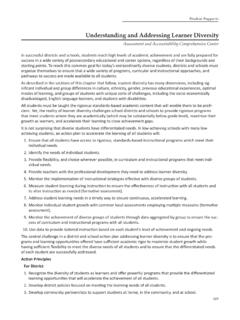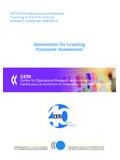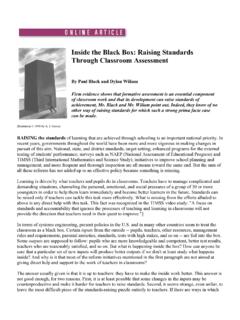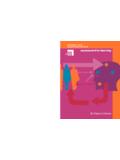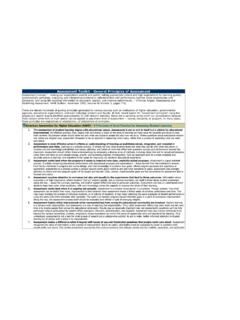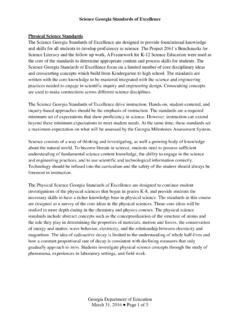Transcription of Using Student Data to Drive Instruction - centerii.org
1 Curriculum and Instruction113 Using Student data to Drive Instruction Center on InstructionThe Using Student Achievement data to Support Instructional Decision Making practice guide published by IES defines data -based decision making as ..teachers, principals, and administrators systematically collecting and analyzing various types of data , including demographic, administrative, process, perceptual, and achievement gap, to guide a range of decisions to help improve the success of students and schools (pp. 46). A number of activities and decisions undertaken by schools and districts involve data -based decision making, such as screening students for placement, Using progress monitoring or formative assessments to determine curricular changes, and interpreting annual performance data to identify areas of weakness for future educational focus.
2 data systems allow for the collection, interpretation, and use of Student data . A universal screening system can be used at the beginning and middle of the school year to identify students who are academically on-track and those who are at-risk for difficulties in key critical content areas, such as reading and mathematics (Gersten, Beckmann, Clarke, Foegan, Marsh, Star, . 2009; Gersten, Compton, Connor, Dimino, Santoro, Linan-Thompson, & Tilly, 2008). At-risk students can be selected to receive research-based interventions. Schools can then use progress monitoring data (collected on a frequent basis) to gauge the students progress (or response to an intervention) towards critical academic outcomes (Tilly, 2008).
3 formative assessments can be collected in classrooms to give teachers feedback about students understanding of the material presented and what minor adjustments to their Instruction may be needed to improve students understanding. Employ the use of data systems in broader decision-making by utilizing annual state testing results to evaluate the effectiveness of their instructional systems. For example, a district may implement a new core reading series and analyze state testing results to determine if the new reading series is increasing Student outcomes, or they may look at areas of poor performance in state testing results to determine where to allocate professional devel-opment PrinciplesFor DistrictDevelop a data system or adopt an available data system that enables analysis of Student outcomes at mul-1.
4 Tiple levels (Hamilton, Halverson, Jackson, Mandinach, Supovitz, & Wayman, 2009).Develop a district-wide plan for collecting, interpreting, and Using data . Dedicate time and develop struc-2. tures for district schools and teachers to use data to alter Instruction (Hamilton, Halverson, Jackson, Mandinach, Supovitz, & Wayman, 2009).Train teachers and principals in how to interpret and use data to change Instruction (Hamilton, Halverson, 3. Jackson, Mandinach, Supovitz, & Wayman, 2009).Use annual state testing performance data to evaluate the overall effectiveness of instructional services 4. provided by the district. Conduct deep analysis to determine areas in need of improvement (Hamilton, Halverson, Jackson, Mandinach, Supovitz, & Wayman, 2009).
5 For SchoolIdentify which students are at risk for difficulties with certain subjects, such as mathematics or reading, and 1. provide more intense Instruction to students identified as at risk (Hamilton, Halverson, Jackson, Mandinach, Supovitz, & Wayman, 2009; Gersten, Beckmann, Clarke, Foegen, Marsh, Star, & Witzel, 2009; Gersten, Compton, Connor, Dimino, Santoro, Linan-Thompson, & Tilly, 2008).Employ efficient, easy-to-use progress monitoring measures to track the progress of students receiving 2. intervention services towards critical academic outcomes (National Center on Response to Intervention, ; Hamilton, Halverson, Jackson, Mandinach, Supovitz, & Wayman, 2009; Gersten, Beckmann, Clarke, Foegen, Marsh, Star, & Witzel, 2009; Gersten, Compton, Connor, Dimino, Santoro, Linan-Thompson, & Tilly, 2008).
6 Curriculum and Instruction114 Use formative assessments to evaluate learning and determine what minor adjustments can be made to 3. Instruction to enhance Student understanding (The National Center for Fair and Open Testing, 2007).References and ResourcesAppalachia Regional Comprehensive Center. ( ) Becoming data smart: A new tool for effective data use. Retrieved from Center for Comprehensive School Reform and Improvement. (2006, January). Using classroom assessment to improve teach-ing. Retrieved from use for continuous quality improvement, , A., & Stecker, P. M. (2009). An introduction to progress monitoring in mathematics: Presenter s manual. Portsmouth, NH: RMC Research Corporation, Center on Instruction .
7 Retrieved from #229 Gersten, R., Beckmann, S., Clarke, B., Foegen, A., Marsh, L., Star, J. R., & Witzel, B. (2009). Assisting students struggling with mathematics: Response to Intervention (RtI) for elementary and middle schools. A practice guide. (NCEE 2009-4060). Washington, DC: National Center for Education Evaluation and Regional Assistance, Institute of Education Sciences, Department of Education. Retrieved from , R., Clarke, B. S., & Jordan, N. C. (2007). Screening for mathematics difficulties in K-3 students . Portsmouth, NH: RMC Research Corporation, Center on Instruction . Retrieved from , R., Compton, D., Connor, C. M., Dimino, J., Santoro, L., Linan-Thompson, S., & Tilly, (2008). Assisting students struggling with reading: Response to Intervention and multi-tier intervention for reading in the primary grades.
8 A practice guide (NCEE 2009-4045). Washington, DC: National Center for Education Evaluation and Regional Assistance, Institute of Education Sciences, Department of Education. Retrieved from , T. (2003). How classroom assessments improve learning . Educational Leadership, 5(60), 6-11. Retrieved from , L., Halverson, R., Jackson, S., Mandinach, E., Supovitz, J., & Wayman, J. (2009). Using Student achievement data to support instructional decision making (NCEE 2009-4067). Washington, DC: National Center for Education Evaluation and Regional Assistance, Institute of Education Sciences, Department of Education. Retrieved from Point Associates, & Educational Service Agency (ESA) Alliance of the Midwest.
9 (2006). Effective use of electronic data systems: A readiness guide for school and district leaders from learning Point Associates. Retrieved from , E., & Stecker, P. (2007). Curriculum-based measurement in mathematics: An evidence-based formative assessment procedure. Portsmouth, NH: RMC Research Corporation, Center on Instruction . Retrieved from , K., Horner, R. H., Chard, D. J., Boland, J., & Good, R. H., III. (2006). The use of reading and behavior screening mea-sures to predict nonresponse to school-wide positive behavior support: A longitudinal analysis. School Psychology Review, 35, 275-291. Synopsis of article. Retrieved from Center for Fair and Open Testing. (2007). The value of formative assessment.
10 Retrieved from Center on Response to Intervention. ( ). Progress monitoring tool chart. Retrieved from , W. D. (2008). The evolution of school psychology to science-based practice: Problem solving and the three-tiered model. In A. Thomas & J. Grimes (Eds.), Best Practices in School Psychology V (Vol. 1 pp. 17-35). Bethesda, MD: The National Association of School Psychologists. Curriculum and Instruction115 Torgesen, J. K. (2006). A comprehensive K-3 reading assessment plan: Guidance for school leaders. Portsmouth, NH. RMC Research Corporation, Center on Instruction . Retrieved from , J. K., & Miller, D. H. (2009). Assessments to guide adolescent literacy Instruction . Portsmouth, NH: RMC Research Corporation, Center on Instruction .
